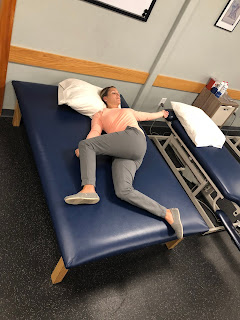Mindset and the Healing Process — Do you Know your Why?
The healing process can feel like a roller coaster ride — one day we’re feeling pretty good,
the next we’re in pain and unable to do what we did the day before. You might feel
limited by pain, or are going through a rehab process and focusing on not only
decreasing pain, but also restoring mobility, strength, and function so that you can get back
into doing what you love to do.
Our ability to ride these roller coaster waves with some modicum of grace greatly
influences the healing process. Healing is not linear and looks a bit like this:
Goiun and Kiecolt-Glaser state “psychological stress and other behavioral factors can affect
wound healing. The relationship between stress and wound repair is not only
statistically significant, but also clinically relevant.”¹
What type of psychological stresses slow the healing process?
Fear pre and post-op, as well as fear avoidance
Optimism, or lack thereof
Depression
Anxiety
Pain
Interpersonal conflicts/disagreements
Anger
Apathy
Over the next few blog posts, I will be sharing with you some of the key factors towards
managing and reducing stress, that you can immediately implement, in order to optimize
your healing process and help you to get back into doing what you do.
In today’s blog, we’ll dive into discovering what I like to call “your why.”
Why is it important to discover your why?
Your why will be one of the key motivators that keeps you going when
you experience challenging days.
Grab a piece of paper and write down these questions.
Then, write down your answers to the questions.
Why do you want to get better?
What do you want to be able to do?
Why do you want to do that?
How will you feel once you are able to reach your rehabilitative goals?
There are no right or wrong answers. The answers will be unique to you, your lifestyle,
and your process. Perhaps you want to be able to pick up your kids again, be able to
walk without fear of falling over, or return to playing sports. Close your eyes and picture
yourself doing whatever it is your particular goal is, your why is.
Allow yourself to see yourself doing it in action and notice how you feel.
This is the place where visualization meets manifestation, meets action, and in this case,
meets healing.
It’s a technique used by actors, sports players, millionaires, etc to bring what they want into the NOW.
Before doing your home exercise program, envision yourself where you want to be,
feel yourself there, then take action and do your program.
Anytime you start to feel stress-inducing emotions, or reactions, breathe and revisit your why.
References:
1Goiun, Jean-Phillipe and Janice K. Kiecolt-Glaser.
The Impact of Psychological Stress on Wound Healing: Methods and Mechanisms.
Immunol Allergy Clin North Am 2011 Feb: 31(1): 81-93.
Image: allennance.com
About Amanda Leigh Patti:
Amanda is a High Performance Mentor and Mindset Coach.
As a single mother of two amazing young men and an entrepreneur, she understands the
unique demands and stressors that balancing business and personal life entails.
She has used a variety of holistic modalities to move through pain, stress, and fear after
leaving an emotionally abusive marriage, recover from physical injury after a car accident
and debilitating yoga injury, and become a powerful advocate for her children.
She excels at helping high performers reduce stress and overwhelm, increase their intrinsic
happiness, and develop more intimate relationships.
Amanda has been studying and practicing the art of personal growth, movement, and relationships for the past 23 years. In 2014, she became a Certified Holistic Lifestyle Coach with the CHEK Institute. She is also a Certified Yoga Teacher, movement teacher, and humanitarian. At the heart of her work, Amanda has a desire to connect people to the core of who they are through a multi-dimensional approach to healing, rooted in traditional wisdom and modern arts. Find out more about Amanda here: http://amandaleighpatti.com







